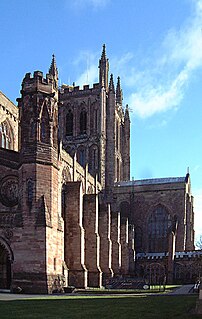Related Research Articles
Maurice was the third Lord Chancellor and Lord Keeper of England, as well as Bishop of London.
Henry Wingham was a Lord Chancellor of England and Bishop of London.
John Chishull or John de Chishull was Lord Chancellor of England, Bishop of London, and Lord High Treasurer during the 13th century. He also served as Dean of St Paul's.
Eustace of Fauconberg was a medieval English Bishop of London from 1221 to 1228 and was also Lord High Treasurer.
Henry of Newark was a medieval Archbishop of York.
Roger Niger was a thirteenth-century cleric who became Bishop of London. He is also known as Saint Roger of Beeleigh.
William Langton was a medieval English priest and nephew of Archbishop Walter de Gray. William was selected but never consecrated as Archbishop of York and Bishop of Carlisle.
Robert de Chauncy was a medieval Bishop of Carlisle.

William of Louth, also known as William de Luda was a medieval Bishop of Ely.
Ralph Walpole was a medieval Bishop of Norwich and Bishop of Ely.

Richard Swinefield was a medieval Bishop of Hereford, England. He graduated doctor of divinity before holding a number of ecclesiastical offices, including that of Archdeacon of London. As a bishop, he dedicated considerable efforts to securing the canonisation of Thomas de Cantilupe, his predecessor, for whom he had worked during his lifetime. Active in his diocese, he devoted little time to politics. He was buried in Hereford Cathedral where a memorial to his memory still stands.
Henry of Lexington was a medieval Bishop of Lincoln.
Richard of Gravesend was a medieval Bishop of Lincoln.
Oliver Sutton was a medieval Bishop of Lincoln, in England.
William the Norman was a medieval Bishop of London.
Richard de Belmeis was a medieval cleric, administrator and politician. His career culminated in election as Bishop of London in 1152. He was one of the founders of Lilleshall Abbey in Shropshire.
William of Sainte-Mère-Église was a medieval Bishop of London.
Henry of Sandwich was a medieval Bishop of London.
Fulke Lovell was a medieval Bishop of London-elect.

Richard Marsh, also called Richard de Marisco, served as Lord Chancellor of England and Bishop of Durham.
References
- Fryde, E. B.; Greenway, D. E.; Porter, S.; Roy, I. (1996). Handbook of British Chronology (Third revised ed.). Cambridge: Cambridge University Press. ISBN 0-521-56350-X.
- Greenway, Diana E. (1968). "Archdeacons: Essex". Fasti Ecclesiae Anglicanae 1066-1300. Vol. 1, St. Paul's, London. Institute of Historical Research. Retrieved 29 October 2007.
- Greenway, Diana E. (1968). "Bishops". Fasti Ecclesiae Anglicanae 1066-1300. Vol. 1, St. Paul's, London. Institute of Historical Research. Retrieved 29 October 2007.